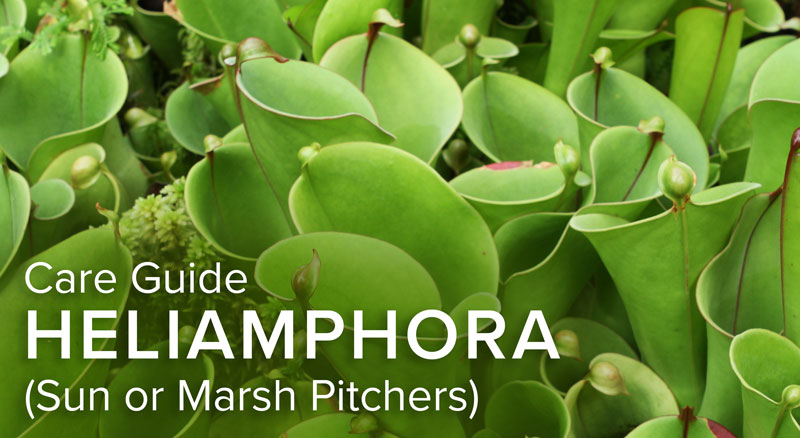
Heliamphora, commonly called Sun or Marsh Pitchers, is a carnivorous plant that catches insects with its unique pitchers. The sun pitcher plants are mainly found in Brazil and Venezuela. The plant catches insects to compensate for the nutrient-poor soil it grows on. The tiny bud at the top of the plant contains the nectar glands, which lure insects. Once on the rim, the animal loses grip and falls into the digestive liquid. The cups are smooth, and because moisture remains in the cup, insects cannot escape. The Heliamphora is not difficult to grow, but you need to be aware of a few things.
Watering
Water the Heliamphora sufficiently and ensure that the plant never stands in dry soil by keeping it moist. It is best to water the plant from above. It is all right if a bit of water gets in their pitchers because this happens naturally in the wild when it rains, but do not fill the cups with water, as the plant will take care of this itself. Ensure that excess water can drain through holes in the bottom of the pot because the Heliamphora does not like it when the roots are constantly standing in a layer of water. The plant will then go mouldy or rot. On hot days, it may be a good idea to water in the morning and the evening, but Heliamphora shouldn’t experience temperatures above approximately 25° C. The plant only produces cups if the humidity is very high. So use a plant sprayer to mist water over the plant. Another option is to grow the plant in a terrarium or use a water evaporator. Only rainwater or demineralised water should be used for both watering and misting. Tap water contains an enormous amount of lime and minerals, which the Heliamphora does not tolerate well.
Soil
These fragile carnivorous plants dislike to be moved because the plant roots are very brittle, so it is better to avoid repotting. Instead, use a large pot for the Heliamphora so that you will not have to repot the plant for its entire life. If you choose to repot the plant, transplant the Heliamphora in winter when the growth is slow. Make sure the soil is airy and free of added fertiliser and nutrients. The Heliamphora gets its nutrition from captured insects and not from the soil. The soil needs to be both well-aerated and retentive of moisture. If possible, use live sphagnum moss. Otherwise, a simple mix of equal parts dry long-fibre sphagnum moss and perlite will work.
Habitat
Heliamphora needs stable growing conditions. They will acclimate to lower humidity if the temperatures are relatively stable throughout the day. However, many growers have had success growing Heliamphora in sunny, draft-free windowsills where temperatures remain between 16° and 25°C. Otherwise, this is one of the few exceptions in which a well-ventilated terrarium may be a good option, to stabilise both temperature and humidity.
Sunlight
Heliamphora requires a fair amount of sunlight. Choose a spot with preferably direct sunlight, for example, a window facing south, because the plant can hardly stand in too much light. Ensure not to place the plant on a windowsill above a radiator because the air is drier. Unfortunately, increasing the sunlight in most homes also means increasing the ambient temperature, which will work against the plant, so make sure that the temperatures stay below 25C. Never give your plant direct sunlight while it’s in a terrarium – this will increase the temperature, and your plant will not survive the heat. Many Heliamphora will develop rich colours when given bright sunlight.
Feeding
Heliamphora plants can eat various insects, such as fruit flies and mealworms. Sun pitchers are weak feeders, and they will usually catch the insects themselves. Feed them a tiny insect or two once in 2-3 weeks if they can’t do this themselves. Check the trap is empty before dropping another insect.
Winter care
The Heliamphora does not go dormant in winter. Even though the Heliamphora can take a light frost, they are not winter hardy, so ensure they are kept inside during the cooler months. Also, the Heliamphore doesn’t need that many nutrients during the winter months, so you don’t have to feed them regularly. Finally, make sure that they get enough light. Use 40-watt fluorescent tubes or compact fluorescent bulbs, but make sure they are equivalent to 100 watts or more. Keep the light source approximately 6-8 inches above the plant. The light should be on for 16 hours during spring and summer and twelve hours during fall and winter. Avoid incandescent bulbs because they produce too much heat and the wrong light spectra.
